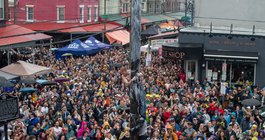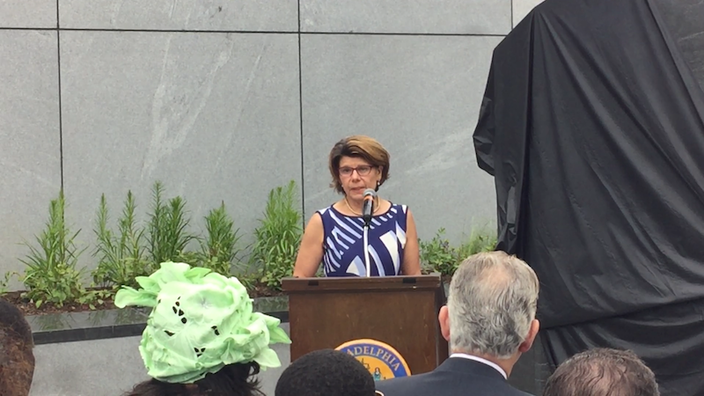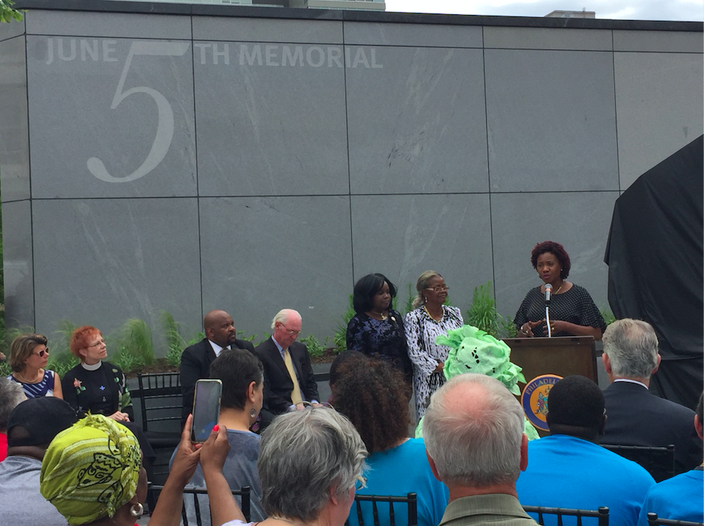
June 05, 2018
 Brian Hickey/PhillyVoice
Brian Hickey/PhillyVoice
Survivors of those killed in the June 5, 2013 Salvation Army thrift store building collapse at the memorial unveiled at the site five years to the day later.
Moments after Tuesday's emotional dedication of the June 5 Memorial Park at 22nd and Market streets, Nancy Winkler stood among her fellow mourners near a trio of large granite stones commemorating those who died on the very spot five years ago to the day.
There were so many people on hand that the crowd spilled out into the street. Police blocked northbound traffic along 22nd Street to accommodate a moment that merged grief, anger and a call to never again let greed outweigh the value of human life.
As people started dispersing around noon on Tuesday, Winkler pointed to the ground and said there, right there, is where my 24-year-old daughter Anne Bryan died after spending 10 hours trapped in rubble of the Salvation Army Thrift Store collapse.
“I called her over and over again,” Winkler said of a day that’s consumed her life ever since, and will admittedly do so forever. “I kept calling her phone in case she was conscious. I hope she knew I was thinking of her, looking for her.
"She lived for many hours, in (an air) pocket. But slowly, she died.”
 Brian Hickey/PhillyVoice
Brian Hickey/PhillyVoiceNancy Winkler speaks at the June 5th Memorial Park unveiling.
When she went to the Medical Examiner’s Office to identify Anne, an aspiring art student, she looked through a window and couldn’t discern any visible trauma that belied the nature of her death on a day that killed six people and injured 14 others.
“That was horrible. It was hard to comprehend that she was dead. It still is,” Winkler said, noting that getting that exact location would help her accept that reality. “I was asking because I wanted to understand what had happened, so we could respect the space where (the six victims) were.”
That, said Winkler, is what June 5th Memorial Park will not only do for her, but for fellow mourners, total strangers and future generations who pass by the solemn site.
The memorial park, which Winkler spearheaded, is an unassuming tribute to those lost when the wall of a neighboring building undergoing demolition collapsed onto the Salvation Army thrift shop.
Aside from the granite monuments, there’s a wall that runs about a half-block deep to the alley between it and the Mutter Museum. A parking lot sits on the land where the building that collapsed stood on June 5, 2013.
In addition to Anne Bryan, the tragedy also claimed the lives of Roseline Conteh, 52; Borbor Davis, 68; Kimberly Finnegan, 35; Juanita Harmon, 75; and Mary Simpson, 24.
Their names adorn the pillars, right above six of seven colorful glass squares. (The seventh symbolizes the grief of all human loss.)
The death count did not end at six. Danny Johnson, who was in the store during the collapse, was injured but survived the immediate collapse, and died about three weeks later. And Ronald Wagenhoffer, the Department of Licenses and Inspections inspector in charge of inspecting the site, who subsequently committed suicide.
"For me, it was devastatingly life-altering. My daughter Anne was crushed to death, right here." – Nancy Winkler
The collapse landed general contractor Griffin Campbell and excavator operator Sean Benschop behind bars for up to 30 and 15 years, respectively, for involuntary manslaughter. At a civil trial that ended early last year, survivors settled for $227 million collectively.
“On a beautiful late spring morning in 2013, the reckless demolition of a neighboring building collapsed a wall onto the Salvation Army store that stood on this site,” reads the beginning of an inscription on the monument’s wall.
It was a beautiful late spring morning in 2018 that brought the families of all the victims together for the first time since the tragedy, on land donated by the Salvation Army to the city for the $1.5 million memorial park.
At the outset of the hour-long ceremony, John White – memorial-committee chairman – set a tone that extended beyond the victims of the collapse.
“Human life is more important than development,” he said.
 Brian Hickey/PhillyVoice
Brian Hickey/PhillyVoiceZee Carr, daughter of Salvation Army collapse victim Bobor Davis, spoke about a man 'who will always be remembered.'
Noting that the memorial is dedicated to the victims and their family members, Mayor Jim Kenney echoed that sentiment.
“In life, they were daughters, sons, parents, students, co-workers and friends. We could never forget them,” said Kenney, who served in City Council at the time of the collapse. “It is fitting to have this special place of contemplation in their memory.
“Today, we renew our pledge to honor them while never, ever forgetting the lessons that this memorial teaches. By never putting profit ahead of people. By insisting that construction projects be conducted safely. By making that 911 call when we see danger. By making safety our highest priority of all, with no exceptions.”
Among the other speakers were Borbor Davis’ daughter, Zee Carr, and Juanita Harmon’s brother Charles, who said he hopes the monument “will inspire commercial workers to make sure to do the proper thing when they construct sites.”
“I’m happy that I made it through this without too many tears,” he said.
After thanking everyone who made the “meaningful” monument possible, Winkler spoke about what she hopes it accomplishes in the name of her daughter and the five others lost in the tragedy.
It blended grief and anger with the hope that nobody ever goes through what they’ve collectively gone through in the past five years.
The monument, she said, is a call for people to be better citizens and “protectors of our fellow Philadelphians” imbued with love and respect for all. She also railed against the injustice that “white-collar higher-ups got criminal immunity” despite the civil trial findings.
“Five years ago, on this site, things went terribly wrong,” she said. “The underlying cause of this tragedy was human greed and outrageous disregard for the lives and safety of our fellow citizens.
“For many, such an outrageous breach of public safety was shocking and deeply upsetting. For me, it was devastatingly life-altering. My daughter Anne was crushed to death, right here.”